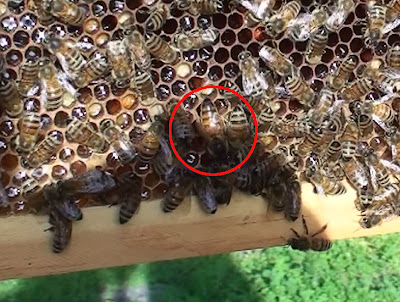So, I gotta tell you, I've been struggling with the bees lately. It's a number of things...the bad weather (which prevents me from checking the hives regularly), bad tempers (mine and the bees' but probably mostly mine), and lack of enough hours in a day.
As you know, our apiary exploded in February, going from one hive to five in a matter of a couple of weeks, which was manageable but only because Tim was home and on swarm watch through the day. More recently, my friend Martin's bees went berserk. Martin is a very busy man, so I have been taking care of his bees. The problem is that I am a very busy woman who doesn't really have time to take care of Martin's bees either. But when it comes down to it, I simply have more optimism than sense.
Anyhoo, on Friday when I finally got around to doing an inspection of Martin's hives, it had been two weeks since my previous inspection. Let me tell you right now, not a good move in the spring. If you take nothing else away from this blog ever, remember this:
get into your hives every week or be prepared to deal with the consequences.
Let's take this one hive at a time:
Alan's nuc: This is a swarm of bees that Martin literally sprayed down from a very tall tree a few weeks ago and put into a nuc box (on loan from Alan). Miraculously, the queen seems to have survived the dousing because there was brood when I checked the hive on Friday. However, she might not have survived the honey flood that I created when I removed the lid and accidentally shook loose a full lobe of comb that the bees had attached to the lid because they were missing a fifth frame. What a mess. I removed the lobe from the bottom of the nuc box and looked for the queen among the dead--I didn't see her. The plan is to get that colony into an 8-frame deep ASAP.
Matin's Swarm: This is where it gets crazy. Someone sold this swarm to Martin in early February. Yes, a swarm in early February--perhaps the first sign that madness would ensue. It consisted of one deep and two supers. Originally, it had one deep and one super and then a super was added between the two original boxes--creating a rather strange hive configuration. For a few weeks, the bees were building drone comb perpendicular to the frames and we had to remove it. This week, I was relieved to see the drone comb going parallel to the frames, and all looked stupendous until I got into the deep and found 10 swarm cells!
I have to confess, I wacked them! I was leaving for the weekend and Martin was unavailable, and I knew that the bees would swarm themselves silly like our hive if I left the swarm cells in tact. I hated to do it, but I cut all of the swarm cells from the frame, letting them fall to the ground. Odd as it sounds, I was somewhat consoled by the fact that the queen cells provided sustenance for some chickens in a neighboring yard. I momentarily considered sucking out the royal jelly, as one old timer beekeeper highly recommended, but that SO did not happen!
In my anxiety and partial blindness (it's hard to see through bee veils) I was moving too fast, and I stepped on most of the queen cells. But after I had re-assembled the hive, I looked down and noticed a virgin queen running around frantically on the swarm cell she had just emerged from. I picked her up, placed her on the 'flight deck' and watched two guard bees arrest her. I don't know if she was allowed to live or not.
Anyway, if you're looking for a beekeeping resource with all of the answers, this is obviously not the blog for you. Every day, often through trial and error, I learn volumes about bees and myself. Some lessons, I obviously have to learn more than once. The big ones being move slow, send the bees love (as they say in 'The Secret Life of Bees'), don't work bees when you're in a hurry.
There's lots to say about our hives, but I am going to leave that for another blog.
Thanks for reading.







 ) building a nest under our patio cover. I was a little aprehensive about her being there because, well because look at that thing; she looks like a stinging machine! I could just imagine a nest bursting forth with hundreds of stinging machines later in the year. But it was fascinating to watch her build the nest. She would collect mud and then plaster it into the corner of the patio, building clusters of long, narrow cells. Each day she would add one new cell. Sometimes the cells were capped and sometime open.
) building a nest under our patio cover. I was a little aprehensive about her being there because, well because look at that thing; she looks like a stinging machine! I could just imagine a nest bursting forth with hundreds of stinging machines later in the year. But it was fascinating to watch her build the nest. She would collect mud and then plaster it into the corner of the patio, building clusters of long, narrow cells. Each day she would add one new cell. Sometimes the cells were capped and sometime open.





































